the 2007 Abstract Presentations - Wound Healing Society
the 2007 Abstract Presentations - Wound Healing Society
the 2007 Abstract Presentations - Wound Healing Society
You also want an ePaper? Increase the reach of your titles
YUMPU automatically turns print PDFs into web optimized ePapers that Google loves.
<strong>Abstract</strong>s<br />
86<br />
EXPRESSION OF THE A-SMA GENE AND CONTRACTILE<br />
ABILITY OF SKIN FIBROBLASTS FROM DIABETIC MICE:<br />
CORRELATION WITH WOUND CLOSURE RATES IN VIVO<br />
AND IMPLICATIONS IN WOUND HEALING<br />
Xiao Tian Wang, MD, Jin Bo Tang, Paul Y. Liu<br />
Department of Surgery, Roger Williams Medical Center, Providence, RI<br />
Purpose: <strong>Healing</strong> potential of <strong>the</strong> wounds in diabetic patients is very limited and<br />
delay or non-healing of diabetic wounds are serious problems that lack efficient<br />
treatments clinically. In this study we investigated how aSMA gene expression is<br />
changed in diabetic skin fibroblasts and contractile ability of collagen gel matrix<br />
decreased by <strong>the</strong> fibroblasts and correlations with in vivo wound closure rate,<br />
and propose novel gene <strong>the</strong>rapy approaches to reverse <strong>the</strong>se detrimental efforts.<br />
Methods: We used 10 db1/db- diabetic mice (BKS. Cg-m1/1Lepr db )and10<br />
littermates. Two skin excision wounds, 0.8 0.8 cm each, were created on <strong>the</strong><br />
back of each mouse, and sizes of <strong>the</strong> wounds were recorded over a post-surgical<br />
4-week period. Excised skin was cultured as explants to obtain skin fibroblasts.<br />
The fibroblasts were seeded into three-dimension collagen gels and changes in<br />
<strong>the</strong> gel dimensions were recorded for a 3-week period. Simultaneously RNA of<br />
cultured skin fibroblasts was extracted to assess <strong>the</strong> levels of expression of <strong>the</strong> a-<br />
SMA gene. a-SMA gene expression in <strong>the</strong> cells from <strong>the</strong>ir littermates (nondiabetic<br />
mice) served as controls. Thereafter we transferred to diabetic skin<br />
fibroblasts exogenous VEGF or PDGF genes and determined <strong>the</strong> changes of<br />
<strong>the</strong> a-SMA gene expression after gene <strong>the</strong>rapy.<br />
Results: The closure rate of <strong>the</strong> skin excision wounds was significantly greater<br />
in <strong>the</strong> db1/db1 mice (20.4 2.1 days) than in <strong>the</strong>ir littermates (15.5 1.9 days)<br />
(p o 0.001). The fibroblasts from <strong>the</strong> db1/db1 mice showed very poor<br />
contractile behavior in <strong>the</strong> three-dimensional collagen gels; in contract, <strong>the</strong> gel<br />
seeded with <strong>the</strong> non-diabetic fibroblasts shrinked very remarkably. The<br />
differences in dimensions of gels seeded with different cells are statistically<br />
significant at 1, 2, and 3 weeks (p o 0.001). Levels of a-SMA gene expression<br />
were significantly lower in <strong>the</strong> db1/db1 diabetic skin fibroblasts than in <strong>the</strong><br />
cells of <strong>the</strong>ir littermates (p o 0.05) and a-SMA gene expression was significantly<br />
elevated by transfer of <strong>the</strong> VEGF and PDGF genes.<br />
Conclusions: Down-regulation of a-SMA gene expression may be responsible<br />
for <strong>the</strong> lower contractile ability of diabetic skin fibroblasts and delay in closure of<br />
<strong>the</strong> skin wounds. This study demonstrated that transfer of growth factor genes<br />
through appropriate gene <strong>the</strong>rapy approaches increases a-SMA gene expression<br />
and can be a potential method to enhance <strong>the</strong> healing rate of diabetic wound.<br />
88<br />
EFFICACY AND MECHANISMS OF NEGATIVE PRESSURE<br />
(VAC) THERAPY IN PROMOTING WOUND HEALING: A<br />
RODENT MODEL<br />
S.M. Jacobs 1 , D. Matissen 1 ,F.Liu 1 , G. Niedt 2 , MD, J. K. Wu 1<br />
1 Division of Plastic & Reconstructive Surgery,<br />
2 Department of Dermatology, Columbia University College of Physicians &<br />
Surgeons, New York, NY<br />
Introduction: The Vacuum-Assisted Closure device (VAC) has revolutionized<br />
wound care, although <strong>the</strong> exact mechanism is not well understood. We<br />
hypo<strong>the</strong>size that mechanical stress imposed by <strong>the</strong> VAC device on wounds<br />
induces production of pro-angiogenic factors, stimulates formation of granulation<br />
tissue, and promotes secondary healing.<br />
Methods: Full-thickness 2 2 cm excisional wounds were created on <strong>the</strong> dorsa<br />
of rats and divided into three groups: 1) Control (Tegaderm dressing); 2) Special<br />
Control (VAC foam and Tegaderm dressing); and 3) VAC (VAC dressing with<br />
125 mm Hg continuous negative pressure). <strong>Wound</strong> tissues were harvested and<br />
areas were measured on POD 0, 3, 5, 7. <strong>Wound</strong> closure rates (WCR) were<br />
calculated. Tissues were stained for Factor VIII and Masson’s Trichrome for<br />
vessel and collagen content, respectively. Protein was extracted from <strong>the</strong><br />
remaining tissue for western blot analysis of CD31, vascular endo<strong>the</strong>lial growth<br />
factor (VEGF), and basic fibroblast growth factor (bFGF) content.<br />
Results: VAC-treated wounds had statistically significant WCR over all time<br />
points compared to <strong>the</strong> control and special control wounds: POD 3: 31% versus<br />
9% and 9%, respectively, (p o 0.0001); POD 5: 45% versus 24% and 23%,<br />
respectively, (p = 0.0003); POD7: 54.4% versus 43.0%and 31.5%, respectively,<br />
(p o 0.0001). VAC wounds had greater vascularity and collagen deposition<br />
compared to <strong>the</strong> controls at all time points. Expression of CD31, VEGF, and<br />
FGF-2 were higher in VAC wounds by POD 5; however, <strong>the</strong>re was no<br />
difference in POD 3 & 7.<br />
Conclusion: A novel rodent animal model was used successfully to study VAC<br />
wound healing. There is increased wound contraction and collagen deposition<br />
by POD 3, as well as increased production of VEGF and bFGF by POD 5.<br />
Fur<strong>the</strong>r application of this rat model and analysis of wound tissue will fur<strong>the</strong>r<br />
elucidate <strong>the</strong> mechanism of <strong>the</strong> VAC device in promoting improved wound<br />
healing.<br />
87<br />
IN VITRO EFFECTS OF CALRETICULIN CORROBORATES<br />
ITS ROLE IN HEALING OF DIABETIC WOUNDS<br />
M.R. Greives, C.L. Cadacio, K.M. Blechman, M. Rahman, J.P. Levine<br />
L.I. Gold New York University School of Medicine, New York, NY USA<br />
Defective wound healing with consequential morbidities has become an<br />
increasingly serious clinical problem in urgent need of novel <strong>the</strong>rapies. We have<br />
discovered that <strong>the</strong> ER chaperone protein, calreticulin (CRT), enhances wound<br />
healing. To determine whe<strong>the</strong>r CRT can specifically improve <strong>the</strong> healing of<br />
diabetic wounds and <strong>the</strong> mechanisms involved, we analyzed <strong>the</strong> effect of CRT<br />
in repair of excisional wounds in diabetic mice (lep-/lep-) and compared normal<br />
and diabetic wound cells in in-vitro migration and proliferation assays. CRT<br />
(50 mg/day for 4 days) was applied to dorsal wounds (6 mm) that were splinted<br />
open to prevent wound contraction, <strong>the</strong> mice injected with BrDU, and <strong>the</strong><br />
wounds harvested 3,7,10,14, and 28 days post-wounding. CRT induced a<br />
decrease in time to closure of <strong>the</strong> diabetic wounds (day 17 vs. 21; p o 0.05)<br />
with a remarkable appearance of dermal appendages at day 28 that were<br />
lacking in <strong>the</strong> untreated controls. Accordingly, epi<strong>the</strong>lial gap was reduced at<br />
days 7 and 10 (p 0.05) and granulation tissue was markedly increased at day<br />
7 (p 0.0006). Histologically, <strong>the</strong> CRT-treated wounds appeared highly<br />
cellular with increased BrDU positive proliferating basal keratinocytes and<br />
fibroblasts (p 0.05). By picrosirius red staining, increased collagen organization<br />
was observed. In-vitro, CRT induced chemotaxis of human fibroblasts,<br />
keratinocytes and macrophages with maximal induction at 100 ng/ml, 10 pg/ml<br />
and 1 ng/ml, respectively, and greater than positive controls (p o 0.05). Importantly,<br />
whereas <strong>the</strong> diabetic cellular counterparts exhibited decreased<br />
migration of positive controls, CRT partially restored <strong>the</strong>ir migratory capacity.<br />
Fur<strong>the</strong>rmore, CRT (100 pg/ml) maximally induced proliferation of keratinocytes<br />
and fibroblasts by 2.2-fold and 8.3-fold, respectively over <strong>the</strong> untreated<br />
controls. The responses obtained in-vitro support <strong>the</strong> physiological mechanisms<br />
involved in CRT-induced enhanced closure and cellularity of <strong>the</strong> diabetic<br />
wounds. We conclude that CRT has <strong>the</strong> potential to be a powerful topical<br />
<strong>the</strong>rapeutic for <strong>the</strong> treatment of diabetic wounds through multiple biological<br />
effects. This work was supported by Calretex, LLC.<br />
<strong>Wound</strong> Rep Reg (<strong>2007</strong>) 15 A14–A54 c <strong>2007</strong> by <strong>the</strong> <strong>Wound</strong> <strong>Healing</strong> <strong>Society</strong><br />
A37




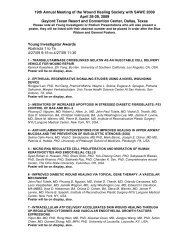

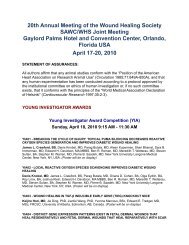
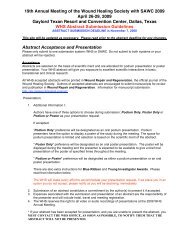
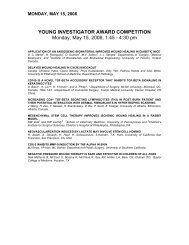



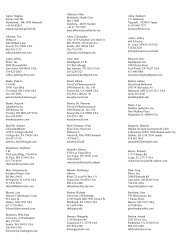
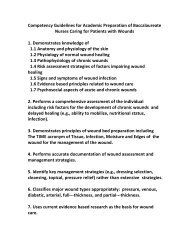
![2010 Abstracts-pah[2] - Wound Healing Society](https://img.yumpu.com/3748463/1/190x245/2010-abstracts-pah2-wound-healing-society.jpg?quality=85)